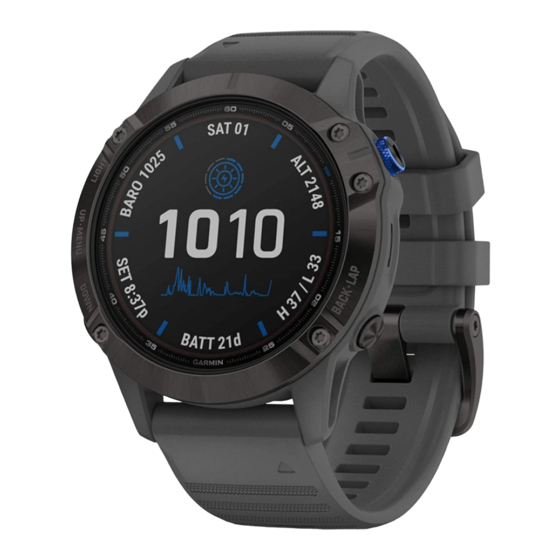Garmin Vivoactive 4 Instrukcja obsługi - Strona 8
Przeglądaj online lub pobierz pdf Instrukcja obsługi dla Oglądaj Garmin Vivoactive 4. Garmin Vivoactive 4 29 stron. Turn on smart watch of 2022 - go wiki
Również dla Garmin Vivoactive 4: Jak to zrobić (8 strony), Instrukcja obsługi (38 strony)

NOTE: The optical sensor is located on the back of the
device.
• See
Tips for Erratic Heart Rate Data, page 6
information about wrist-based heart rate.
• See
Tips for Erratic Pulse Oximeter Data, page 7
information about the pulse oximeter sensor.
• For more information about accuracy, go to
/ataccuracy.
• For more information about device wear and care, go to
www.garmin.com/fitandcare.
Tips for Erratic Heart Rate Data
If the heart rate data is erratic or does not appear, you can try
these tips.
• Clean and dry your arm before putting on the device.
• Avoid wearing sunscreen, lotion, and insect repellent under
the device.
• Avoid scratching the heart rate sensor on the back of the
device.
• Wear the device above your wrist bone. The device should
be snug but comfortable.
• Wait until the
icon is solid before starting your activity.
• Warm up for 5 to 10 minutes and get a heart rate reading
before starting your activity.
NOTE: In cold environments, warm up indoors.
• Rinse the device with fresh water after each workout.
Viewing the Heart Rate Widget
The heart rate widget displays your current heart rate in beats
per minute (bpm) and a graph of your heart rate. The graph
shows your recent heart rate activity, high and low heart rate,
and color-coded bars to indicate the time spent in each heart
rate zone
(About Heart Rate Zones, page
1
From the watch face, swipe to view the heart rate widget.
2
Tap the touchscreen to view your average resting heart rate
(RHR) values for the last 7 days.
Setting an Abnormal Heart Rate Alert
This feature only alerts you when your heart rate exceeds or
drops below a certain number of beats per minute, as selected
by the user, after a period of inactivity. This feature does not
notify you of any potential heart condition and is not intended to
treat or diagnose any medical condition or disease. Always defer
to your health care provider for any heart-related issues.
1
Hold
.
2
Select
> Wrist Heart Rate > Abnormal HR Alert.
3
Select High Alert or Low Alert.
6
for more
for more
garmin.com
6).
CAUTION
4
Select a heart rate threshold value.
5
Select the toggle to turn on the alert.
Each time you exceed or drop below the custom value, a
message appears and the device vibrates.
Broadcasting Heart Rate to Garmin Devices
You can broadcast your heart rate data from your vívoactive
device and view it on paired Garmin devices. For example, you
can broadcast your heart rate data to an Edge
cycling.
NOTE: Broadcasting heart rate data decreases battery life.
1
Hold
.
2
Select
> Wrist Heart Rate.
3
Select an option:
• Select Broadcast In Activity to broadcast heart rate data
during timed activities
• Select Broadcast to start broadcasting heart rate data
now.
4
Pair your vívoactive device with your Garmin ANT+
compatible device.
NOTE: The pairing instructions differ for each Garmin
compatible device. See your owner's manual.
Turning Off the Wrist-based Heart Rate Monitor
The default value for the Wrist Heart Rate setting is Auto. The
device automatically uses the wrist-based heart rate monitor
unless you pair a chest heart rate monitor to the device. Chest
heart rate data is only available during an activity.
NOTE: Disabling the wrist-based heart rate monitor also
disables your VO2 max. estimate, intensity minutes, the all-day
stress feature, and the wrist-based pulse oximeter sensor.
NOTE: Disabling the wrist-based heart rate monitor also
disables the on-wrist detection feature for Garmin Pay
payments, and you must enter a passcode before making each
payment
(Garmin Pay, page
1
Hold
.
2
Select
> Wrist Heart Rate > Status > Off.
About Heart Rate Zones
Many athletes use heart rate zones to measure and increase
their cardiovascular strength and improve their level of fitness. A
heart rate zone is a set range of heartbeats per minute. The five
commonly accepted heart rate zones are numbered from 1 to 5
according to increasing intensity. Generally, heart rate zones are
calculated based on percentages of your maximum heart rate.
Setting Your Heart Rate Zones
The device uses your user profile information from the initial
setup to determine your default heart rate zones. The device
has separate heart rate zones for running and cycling. For the
most accurate calorie data during your activity, you should set
your maximum heart rate. You can also set each heart rate
zone. You can manually adjust your zones on the device or
using your Garmin Connect account.
1
Hold
.
2
Select
> User Profile > Heart Rate Zones.
3
Select Default to view the default values (optional).
The default values can be applied to running and cycling.
4
Select Running or Cycling.
5
Select Preference > Set Custom.
6
Select Max. HR, and enter your maximum heart rate.
7
Select a zone, and enter a value for each zone.
device while
®
(Starting an Activity, page
®
4).
Heart Rate Features
10).
